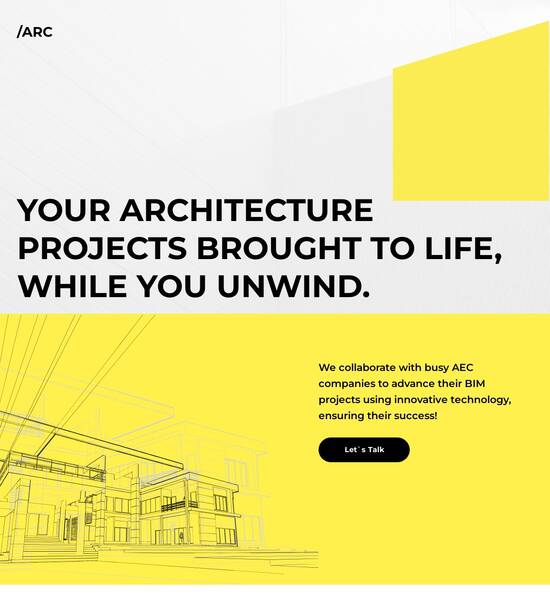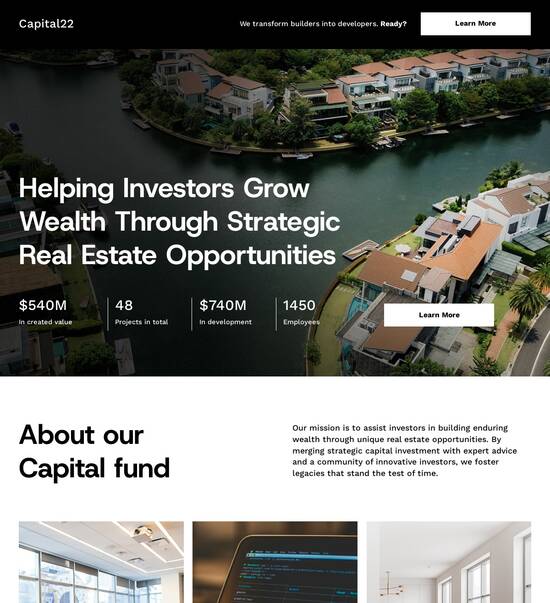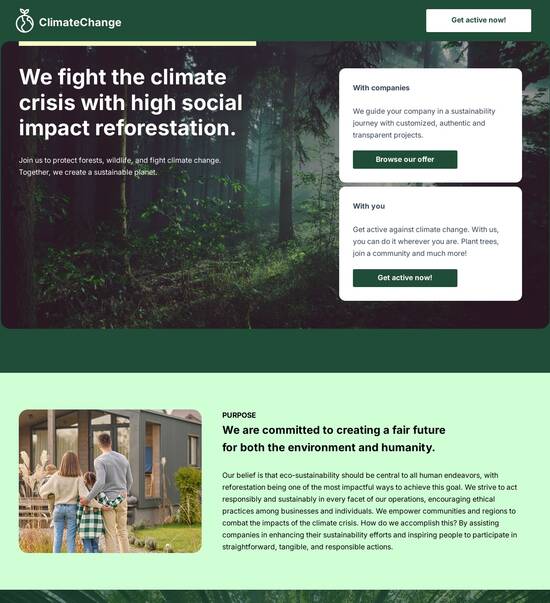
HTML page templates with multilingual support
Explore Similar TemplatesAbout template
Manage your templates with multilingual support and improve your conversion rates. Easily facilitate trust and transparency with your customers right now.
Recommended templates

Easy to build without coding
With the intuitive drag-and-drop builder, anyone on your team can create high-converting pages without any knowledge of code or design. Make enhancements to your landing page with custom widgets using Javascript, HTML/CSS, or third-party scripts.

Multiple layouts for any industry and goal
Select from 500+ landing page layouts built to boost conversions across industry-specific scenarios. Customize them by adjusting fonts, adding images, and generating on-brand content with the AI assistant. Quickly scale with Instablocks® and Global Blocks that you can save, reuse, and update globally.

Loads fast and looks polished on any device
Every template is responsive, which means they present professionally on any device and load blazingly fast with our Thor Render Engine. You can also power them up with Google AMP technology to deliver an unparalleled mobile experience and drive higher conversions.

Robust analytics & experimentation
Get real-time updates and reporting across all your devices, showing the number of visitors, conversions, cost-per-visitor, and cost-per-lead. Launch AI-powered experiments, run A/B tests, and use heatmaps to analyze user behavior, then optimize your landing page to maximize conversions.







Easy to build without coding
With the intuitive drag-and-drop builder, anyone on your team can create high-converting pages without any knowledge of code or design. Make enhancements to your landing page with custom widgets using Javascript, HTML/CSS, or third-party scripts.
Multiple layouts for any industry and goal
Select from 500+ landing page layouts built to boost conversions across industry-specific scenarios. Customize them by adjusting fonts, adding images, and generating on-brand content with the AI assistant. Quickly scale with Instablocks® and Global Blocks that you can save, reuse, and update globally.
Loads fast and looks polished on any device
Every template is responsive, which means they present professionally on any device and load blazingly fast with our Thor Render Engine.
Robust analytics & experimentation
Get real-time updates and reporting across all your devices, showing the number of visitors, conversions, cost-per-visitor, and cost-per-lead. Launch AI-powered experiments, run A/B tests, and use heatmaps to analyze user behavior, then optimize your landing page to maximize conversions.
All the features you need to build multi language website template
Explore more featuresLearn how to build multilingual web page templates
Frequently asked questions about free multi language website template
Leading the way in building high-performing landing pages





Multi language website template free download: Your ultimate how-to guide
Creating and optimizing landing pages is crucial for maximizing the ROI of your digital marketing campaigns. With Instapage, you gain access to a comprehensive platform designed specifically for marketers in various verticals, including education, tech, business services, and financial sectors. This guide will walk you through the essential steps to leverage Instapage's features for successful campaign execution.
Understanding the foundation of landing pages
Landing pages are standalone web pages created for a specific marketing campaign. Their primary objective is to drive conversions by capturing leads or guiding visitors toward a predetermined action. Utilizing Instapage's templates allows users to bypass the complexities of web development and focus on effective marketing strategies. Here are critical aspects to consider when optimizing landing pages:
- Clear value proposition: Make sure your landing page communicates a compelling reason for visitors to provide their information or take action.
- Mobile responsiveness: Ensure your landing page is optimized for mobile devices, as a significant portion of traffic comes from phones and tablets.
- A/B testing: Use Instapage's built-in experimentation features to compare variations of your landing pages and determine what resonates best with your audience.
Step 1: Selecting the right landing page template
Begin with Instapage's extensive library of over 100 high-converting templates that cater to various marketing needs. Selecting the right template sets a solid foundation for your campaign's future success. Here's how to choose the perfect template:
- Audience alignment: Identify which template best fits your target audience's preferences and expectations for a seamless experience.
- Campaign objectives: Consider how the template’s layout and design elements will support your specific campaign goals, such as lead generation or promoting a service.
- Customization options: Ensure the template allows for easy customization so you can tailor it to reflect your brand's identity.
Step 2: Personalizing the content
Once the template is selected, personalization plays a vital role in enhancing conversion rates. Instapage provides various personalization features to deliver tailored experiences for different audience segments. Focus on:
- Dynamic text replacement: Customize key phrases based on user data to communicate more effectively with each visitor.
- AdMaps: Align specific ads to corresponding landing pages to maintain consistency in messaging and elevate user experience.
- Behavior tracking: Utilize analytics tools to monitor audience engagement and performance metrics to adjust your content accordingly.
Step 3: Enhancing collaboration on landing page development
Efficient collaboration is essential for faster turnaround times when creating high-quality landing pages. Leverage Instapage's built-in collaboration features for the following:
- Real-time feedback: Use the commenting system to give instant feedback on design and content, speeding up the review process.
- Page sharing: Securely share pages with stakeholders for additional insights and approvals to ensure all perspectives are considered.
- Version control: Keep track of changes and past versions of landing pages to assess what works and what doesn’t during iterative testing.
By following these steps and effectively utilizing Instapage's robust features, marketers can significantly enhance their landing pages and drive better results.
Start transforming your digital marketing campaigns today with Instapage. Explore how customizable templates and powerful optimization tools can enhance your landing page strategy for maximum conversions.
People also ask about html website templates
HTML page template with multilingual support
Understanding HTML page templates with multilingual support
In an increasingly interconnected world, an HTML page template with multilingual support is becoming essential for websites aiming to reach diverse audiences. This approach allows businesses to communicate effectively with users from different cultural backgrounds, ensuring that information is accessible and engaging. It's essential to recognize that creating a multilingual experience entails more than just translating text—it encompasses understanding the nuances of each language and culture.
The importance of multilingual support in today's digital landscape
Global reach and accessibility are paramount considerations for any business. By providing multilingual capabilities, organizations can expand their audience base significantly. A website that speaks to users in their native language is more likely to foster trust, enhance user experience, and ultimately drive conversions. Cultural relevance plays a vital role in ensuring that content resonates with various demographics, which can influence brand perception positively.
Additionally, the SEO benefits stemming from multilingual support cannot be overlooked. By optimizing web content for different languages, businesses can improve their search visibility. Localized keywords can yield significant improvements in ranking, as search engines increasingly prioritize relevant content that aligns with user queries.
Core elements of a multilingual HTML page template
Structured code is crucial for language flexibility in multilingual HTML templates. The use of the HTML `lang` attribute clearly communicates the language of a particular section of text to search engines and assistive technologies. Semantic HTML practices, such as utilizing proper heading levels and list structures, help establish a coherent hierarchy of information, which is beneficial for all users, particularly those using screen readers.
Storing translations effectively is also essential for managing multiple languages. JSON files can serve as a simple and efficient method for handling language management. By dynamically loading language-specific content with JavaScript, you can create a seamless experience for users, allowing them to switch languages without reloading the entire page.
Designing user-friendly interfaces for multilingual experiences
A user-friendly language picker navigation is vital for enabling effortless language switching. The design of the language selector should be intuitive, ensuring that users can easily find and select their desired language. Examples of effective designs include dropdown menus, flag icons, or language names listed horizontally across the top of the page.
Responsive layout considerations must also be taken into account when designing multilingual templates. Different languages may result in varying text lengths; for example, German words are often longer than their English counterparts. CSS strategies, such as using flexible grid structures and media queries, can help adapt the layout to accommodate different languages without compromising design integrity.
Integrating content through diverse plugins and technologies
Content management systems (CMS) often provide robust support for multilingual features. Popular options like WordPress and Joomla offer plugins that simplify the process of creating and managing multilingual content. These plugins can streamline translation tasks, allowing for more efficient management of different language versions of your website.
For developers seeking custom solutions, utilizing APIs for language translation can enhance content accessibility. Services like Google Translate or Microsoft Translator can be embedded into your web application to provide near-instant translations. Additionally, employing frameworks such as React or Vue.js can enable dynamic language handling, making it easier to create a multilingual application that adapts to user preferences.
Practical steps to creating a multilingual HTML page template
Defining your language strategy is the first practical step in creating a multilingual page template. This involves identifying primary languages based on target locations and communities. Audience research plays a critical role in language selection, helping to ensure that you cater to the preferences of your user base.
Setting up your folder structure in the project is equally important. Organizing your project folder for easy access to language files can lead to a more efficient workflow. Adopting clear file naming conventions, such as using language codes (e.g., en.json, fr.json), will simplify the process of locating and maintaining translations.
Engaging teams in the multilingual development process
Collaboration across diverse teams is essential in ensuring the success of multilingual projects. Developers, marketers, and language experts must work together to create effective translations and user experiences. Best practices for cross-functional teamwork can help streamline efforts and ensure that everyone is aligned on project goals.
Involving local experts is also beneficial. Consulting native speakers can lead to accurate translations that respect cultural nuances. Organizing workshops for feedback allows for continuous improvement and fosters a sense of ownership within the development process.
FAQs: common questions about multilingual HTML templates
What are the key considerations for mobile responsiveness in multilingual designs?
How to address cultural nuances in translations?
What is the best approach for handling right-to-left (RTL) languages?
Advanced techniques for optimizing multilingual pages
Utilizing hreflang tags is an advanced technique that can enhance SEO for multilingual websites. By implementing hreflang attributes in your HTML, you can guide search engines to the language and regional versions of your content. This not only improves user experience but also aids in site indexing by helping search engines understand which version of a page should be displayed to users based on their language settings.
Monitoring and analytics tools are key to tracking user engagement across different languages. Google Analytics, for instance, can provide insights into how users from various linguistic backgrounds interact with your website. Analyzing language performance allows for necessary content adjustments, ensuring that all users find relevant information.
Exploring real-world examples and case studies
Examining successful multilingual templates provides valuable insights into effective design and implementation strategies. Websites like IKEA and Airbnb serve as prime examples of organizations that have effectively utilized multiple languages to enhance user experience and drive conversions. Their approach often includes comprehensive localization efforts and an intuitive language-switching mechanism.
Community contributions and feedback loops also play a critical role in optimizing multilingual content. Gathering insights from user communities about their language preferences can inform future content strategies. Employing A/B testing can refine the multilingual experience by allowing businesses to evaluate which content resonates more with their audience.
Future trends in multilingual web development
Emerging technologies, particularly in AI and machine learning, are accelerating multilingual capabilities in web development. Tools that offer improved translation accuracy are becoming increasingly sophisticated, leading to an overall better user experience. Additionally, the integration of augmented reality (AR) into multilingual environments is on the rise, allowing users to experience content in an interactive and engaging format.
As remote work continues to extend globally, the demand for multilingual content will likely increase. Businesses must be agile in adapting to these changes, developing strategies to meet the evolving language requirements of their audiences. Encouraging real-time feedback and iterating on the user experience will remain paramount.
Summary of key takeaways
Multilingual support is vital for enhancing audience reach and accessibility. By adopting innovative coding practices, businesses can create effective HTML page templates that cater to various language needs. Engaging with community inputs and experts can foster a rich multilingual experience, ultimately driving conversions and increasing brand loyalty.
Ready to skyrocket conversions?
Supercharge your ad campaigns with high-performing landing pages
Get started














